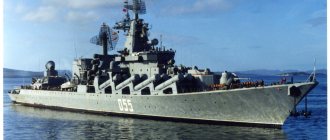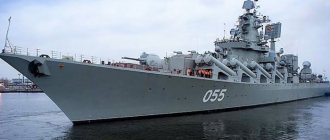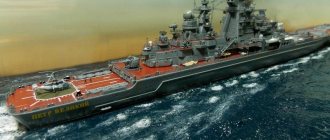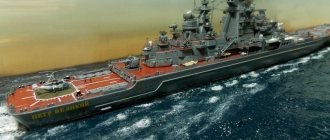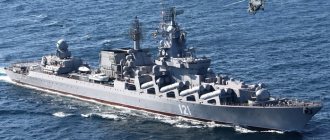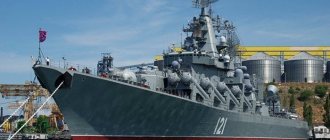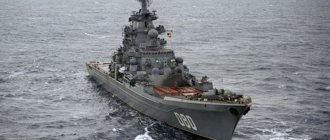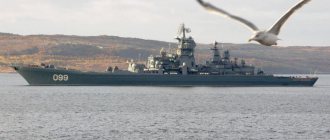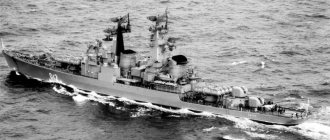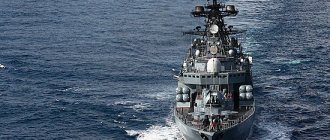The Northern Fleet is perhaps the most powerful in the Russian naval forces. It is there that the heavy cruiser Pyotr Velikiy and the aircraft carrier Admiral Kuznetsov serve. The service of the missile cruiser Marshal Ustinov, which was its flagship before the commissioning of Petra, is also connected to the north.
This ship, built according to Project 1164 Atlant, played an important role in maintaining the combat effectiveness of the Russian fleet during difficult times for the state’s economy. In the 90s, it was the Atlantas that were the largest and strongest Russian ships in combat service.
Background
By 1970, the surface forces of the USSR Navy consisted mainly of anti-submarine ships. The exception was the Project 58 missile cruisers. However, there were few of them, and they did not pose a significant threat to the growing US aircraft carrier fleet. To correct this situation, designers began work on a new missile cruiser that could destroy any enemy ships, and at the same time would be cheaper to build and operate than the huge nuclear-powered ships of the Orlan project.
The cruisers under development received project number 1164 and the code “Atlant”. The lead ship, Slava, was laid down in Nikolaev in 1976. The next one, Fleet Admiral Lobov, began construction in 1978. This ship will later become the “Marshal Ustinov”.
Design
Already by its appearance and architecture, “Marshal Ustinov” can be identified as a ship designed in the Soviet Union. The long forecastle, strongly inclined stem, pyramid-shaped masts and superstructures with beveled edges indicate its origin. Such contours provide better seaworthiness and reduce radar visibility. The ship's power plant is gas turbines, of which two are propulsion turbines, for cruising, and four afterburners, to ensure maximum speed.
The purpose of the Atlas - the destruction of any ships of a potential enemy - determined the type of its main weapon.
The P-500 Basalt heavy anti-ship missiles were only slightly inferior in capabilities to the Granit that the Orlans were armed with. Since it was impossible to hide the launchers in the hull on the smaller Atlantas, sixteen containers with missiles placed along the sides became the most noticeable detail of the ships' appearance. Including “Marshal Ustinov”.
Installations for launching Fort anti-aircraft missiles, which protect ships from any air targets at long distances, are located below deck, between the smokestacks and the helicopter hangar. Osa missiles, providing short-range defense, are launched from installations on both sides of the hangar.
Artillery weapons are universal, designed both for anti-aircraft fire and for hitting weakly protected surface and ground targets. It consists of a twin 130mm AK-130 artillery mount located in the bow and six 30mm AK-630 automatic cannons. Two of them are located in the bow, in front of the navigation bridge, and two on each side of the central superstructure.
The ship's anti-submarine weapons include two 533mm torpedo tubes, from which missile-torpedoes can also be launched. Two RBU-6000 bomb launchers are located in front of the navigation bridge. A helicopter based on a missile cruiser is also used to combat submarines.
Initially, “Marshal Ustinov” carried the already outdated Ka-25 helicopter; in Russian times it was replaced by a more modern and powerful Ka-27.
After modernizing the ship, the Basalt missiles were replaced with the P-1000 Vulcan. It is possible to replace anti-aircraft missiles with a more modern S-400 complex.
The Vulcan complex was created specifically so that it could easily re-equip ships armed with Basalt. The P-1000 differs from the P-500 in its lightweight design, due to which the firing range is increased.
The weight of the warhead and armor had to be sacrificed, but now the missile can cover a much greater distance while at low altitude and maneuvers better, evading damaging factors.
"Marshal Ustinov" - aircraft carrier fighter
We once did a report on how the shipbuilders of the Severodvinsk shipyard “Zvezdochka” completed the repair and modernization of the missile cruiser “Marshal Ustinov” of project 1164 “Atlant”. And so on October 30, the cruiser set out for the White Sea to carry out the factory sea trials program.
Check out this report from the author. Let us remember the history of this ship:
Photo 1.
They had forgotten about the Marshal Ustinov, which had been undergoing scheduled repairs for five long years since 2011: the name of the cruiser was mentioned in the press extremely rarely, and even then the information was limited to vague messages about the work being carried out. It seemed that this ship was lost to the fleet and was destined to gradually sink to the level of scrap metal. But no, the smoking room is alive! And how alive it is - it entered factory testing like new, leaving, perhaps, only the body and the former name from its “past life.”
Many people have probably also forgotten about Dmitry Fedorovich Ustinov, whose name the missile cruiser bears since 1986. The marshal was related to the fleet only as the Minister of Defense of the USSR, a position he held from 1976 to 1984. His strong point was tank and missile forces, which were preferred in a possible war with NATO.
Photo 2.
But Ustinov did not forget about the Navy: during this period, dozens of warships entered service. And the Project 1164 cruiser, which originally bore the name “Admiral of the Fleet Lobov,” was also laid down when Dmitry Fedorovich was Minister of Defense. So the cruiser deservedly received its name in honor of the “land” commander, and the ship’s crew members proudly call themselves Ustinovites.
During that period, three more missile cruisers of this project were laid down: “Varyag”, “Moskva” and “Ukraine”. The first two are the pride of the Russian Pacific and Black Sea fleets and worthily maintain a combat watch in various waters of the World Ocean. The fate of the “junior” - “Ukraine”, which fell during the division of the Independence fleet, is regrettable.
Photo 3.
This ship never went to sea due to lack of funds and is quietly rusting in the docks of the Nikolaev Shipyard, becoming... a museum of something unknown. Negotiations about the purchase of this ship by Russia have been raised more than once, but always to no avail. In Kyiv they stubbornly insist that “nothing for the Muscovites”, and there are simply no other buyers capable of bringing the cruiser back to life.
"Marshal Ustinov" from the first days of joining the Northern Fleet became an exemplary ship in all respects. Its first commander, Captain 2nd Rank Vladimir Verigin, managed to lay down those good naval traditions that today’s Ustinovites also observe - combat power, multiplied by the skill and discipline of the crew.
Photo 4.
Needless to say, the cruiser, which was constantly on long voyages, was polished from top to bottom, and the copper coamings could be looked at like a mirror. It is no coincidence that in 1989, it was “Marshal Ustinov”, under the pennant of the then first deputy commander of the Northern Fleet, Vice Admiral Igor Kasatonov, who went on a visit to Norfolk, the US naval base.
By the way, Admiral Kasatonov was partial to the Project 1164 Atlant cruisers and valued them for their ocean-going performance and striking power of weapons capable of effectively resisting surface, underwater and airborne enemies. It is no coincidence that when he was the commander of the Black Sea Fleet, Igor Vladimirovich preferred to raise his pennant on the Moskva, the “twin brother” of Marshal Ustinov.
Photo 5.
Over the years of service, the missile cruiser "Marshal Ustinov" not only made friendly visits. This ship completed over 370 combat exercises using missile, artillery and anti-submarine systems. During his campaigns, he covered almost 150 thousand nautical miles (six times along the equator around the Earth!), and spent 1089 days on the open sea.
In 1987–1988 and 1989, the cruiser served in the Mediterranean Sea as part of the Soviet naval group. After scheduled repairs in 1997, “Marshal Ustinov” went to the Atlantic, and then for a long time took part in patrols in the Arctic Ocean around the island of Spitsbergen, ensuring the safety of Russian fishing vessels in the region. I walked around a lot.
Photo 6.
If we talk about the modernization that was carried out on this ship during the repairs at Zvezdochka, we should dwell on its armament. The main thing, as the name suggests, is rocket-based. This is the 16th launcher of the anti-ship missile complex (Basalt launcher).
This is a missile weighing six tons and a flight speed of 3077 kilometers per hour with partial armor, equipped with a powerful (500 kilograms) conventional high-explosive-cumulative or nuclear (350 kilograms) warhead, capable of hitting targets at a range of up to 1000 kilometers. The flight of this anti-ship missile is carried out along a complex trajectory, it is equipped with a telecontrol system and an on-board station for electronic countermeasures against the air defense systems of the attacked ship.
Photo 7.
The cruiser carries on board 96 jet depth charges (RBU-6000), which can destroy enemy torpedoes and submarines at a range of six kilometers at a diving depth of 500 meters (the American Virginia-class nuclear submarine is capable of diving to a maximum of 488 meters). Ten 533 mm torpedoes destroy targets at a range of 22 kilometers, moving towards them underwater at a speed of 100 kilometers per hour.
Anti-aircraft weapons are represented by the S-300F “Fort” (“Reef”) air defense system, which can engage air targets at a horizontal range of 90 and a vertical range of 25 kilometers. Plus six 30-mm AK-630 anti-aircraft guns with a rate of fire of 6,000 rounds per minute. Dual 130-mm AK-130 cannons with a rate of fire of 90 rounds per minute and a range of 24 kilometers are also capable of hitting aerial targets. They also fire at surface targets with success. The cruiser's armament also includes the Ka-27 helicopter (or its modifications), for which there is a platform at the stern of the ship.
Photo 8.
During the modernization, new radar stations were installed on the Marshal Ustinov. The cruiser received a three-dimensional early warning radar "Podberezovik" and a "Fregat-M2M" station with phased antenna arrays optimized for detecting low-flying targets. The modernization work affected all the cruiser's main radio-electronic weapons systems, including electronic warfare (electronic warfare) systems, which make it possible to make the ship invisible to enemy guidance systems.
Photo 9.
The Zvezdochka shipbuilders replaced the entire internal “stuffing” with the Marshal Ustinov, from cables to gas turbine units, which allow the cruiser to reach a speed of 32 knots. The cruiser, with a crew of almost 500 people, has a cruising autonomy of 30 days and is capable of traveling more than 7,500 nautical miles during this time.
Photo 10.
“This is a completely new ship,” says Admiral Vladimir Komoyedov. – Its introduction into the fleet after deep modernization is very timely right now. Considering that an aircraft carrier strike group led by the Admiral Kuznetsov and the heavy nuclear-powered missile cruiser Pyotr Velikiy left the north to carry out tasks in the Mediterranean, the missile cruiser Marshal Ustinov will become a good reinforcement for the rest of the fleet forces in this region.
Photo 11.
APD: in the comments to the article, they almost immediately remembered the “Legend”, which gave target designation to “Basalt” / “Vulcans” and that they say all this is no longer there and that’s the end of the weapon.
However, firstly, the Marshal Ustinov RKR will become the first ship of Project 1164, armed with a full-fledged Vulcan complex with a range of 1000 km.
Photo 12.
And secondly, last year Mashinostroitelny began production of new spacecraft of the Liana series.
In 2022, Roscosmos and the Russian Ministry of Defense will complete the creation in orbit of the newest Russian satellite reconnaissance system, Liana. It will consist of four new radar reconnaissance satellites, which will be based at an altitude of about 1 thousand km above the surface of the planet and constantly scan ground, air and sea space for the presence of enemy objects.
St. Petersburg Arsenal is one of the oldest enterprises in Russia. The main activities of the plant: production of space technology, naval artillery and launchers, as well as general civil engineering products. In Soviet times, the plant produced devices of the Legend naval space reconnaissance and target designation system (MCRTS), designed to target submarines and surface ships with cruise missiles, as well as naval missile-carrying aircraft. Now the project is participating in the creation of the newest ICRC “Liana”. An experimental sample of the Lotos-S satellite was launched into orbit on November 20, 2009 under the designation Kosmos-2455.
Photo 13.
After reaching the design mode, "Liana" will completely replace the outdated "Legend" - "Tselina" system, built in Soviet times, which ceased to function in 2008 due to the depletion of satellite resources.
According to Igor Lisov, a columnist for the specialized publication Cosmonautics News, Liana will several times increase the capabilities of the Russian Armed Forces to detect and destroy enemy targets.
— After the Legend was decommissioned, the Ministry of Defense had a great need for surveillance and target designation equipment. Now “Liana” will be able to satisfy her. "Legend" was created for a narrow task - tracking American warships, in particular aircraft carriers. Its radars could detect objects several tens of meters long. “Liana” solves a wider range of problems and can detect small targets,” explained Igor Lisov.
https://youtu.be/EaQd1JMa48k
Source
Service history
The cruiser was launched in 1982, and delivered to the fleet only in 1986. And just a month after the ship was accepted, a significant event occurred. All Atlantas were subsequently renamed, but this happened immediately with Admiral Lobov. He was given a new name - “Marshal Ustinov”, in honor of the late Minister of Defense of the USSR. With this name, the cruiser went to the Northern Fleet.
Until 1991, the cruiser Marshal Ustinov managed to take part in two military campaigns in the Mediterranean Sea and make an official visit to the United States.
After the collapse of the Soviet Union, the cruiser remained to serve in the north and continued to pay “friendship visits.” At this time, the flagship of the Northern Fleet, the nuclear-powered Kirov, was sent to reserve (and in fact, to waste). The same thing happened with other Orlans.
The ships of the Atlant project turned out to be the most powerful of the combat-ready Russian ships and admirals began to transfer flags to them. The cruiser "Marshal Ustinov", having returned from repairs, led the Northern Fleet. Later he again ceded this post to “Orlan” - this time to “Peter the Great”. This did not make the service any easier - the cruiser spent the beginning of the new century on regular cruises. And in 2011, we embarked on modernization.
The “overhaul” of “Ustinov” dragged on for six years. The completion date was delayed and even rumors leaked that it was too expensive to modernize the cruiser and that it would be cheaper to replace it by purchasing the unfinished fourth ship of the project from Ukraine. But the repair ended successfully, and the cruiser “Marshal Ustinov” returned to Severomorsk in 2022.
Modernization and refurbishment
From 1994 to December 17, 1997
— scheduled repairs at the St. Petersburg JSC Severnaya Verf. During the renovation, the main power plant was replaced.
From July 2011 to October 2016
the ship was undergoing repairs and modernization in (the city of Severodvinsk). During the work, new radars with phased antenna arrays were installed on the cruiser: the Podberyozovik three-dimensional early warning radar and the Fregat-M2M station, optimized for detecting low-flying targets. Also according to the plan, docking work, repairs of the main power plant and general ship systems, inspection and repair of main cables with replacement of defective sections were carried out. In total, more than 150 km of cable routes were replaced, all six gas turbine generators, a desalination plant, pitch stabilizers, shaft lines, propellers, and galley equipment were repaired and replaced; The interior of the ship was put in order. In the fall of 2016, the updated cruiser successfully completed a test program in the White Sea, after which it returned to service in the Northern Fleet.
Specifications
The closest analogue of the Marshal Ustinov in terms of size and displacement is the American missile cruiser Ticonderoga. However, the ships differ quite significantly in purpose. The American cruiser was conceived as a defensive cruiser, protecting aircraft carriers from submarines and aircraft.
The combat missions of the Marshal Ustinov were conceived as directly opposite to the Ticonderoga.
This "Atlant" was supposed to become the main striking force of the squadron, and it was supposed to be covered by carrier-based aircraft. Despite the presence of powerful Fort anti-aircraft missiles, their number on the Atlantas is less than on the nuclear-powered Orlans and less than on the Standard missiles on the Ticonderogas.
In addition, the Aegis radar system on American cruisers can simultaneously fire up to 18 missiles at a target. The Fort's only guidance radar could simultaneously guide only two missiles onto one target. The outdated Igla installations were also criticized.
Of greater interest is the comparison with the newest destroyer of the US Navy, Zamvolt. Although it is considered a destroyer, it is larger in size than most cruisers.
| "Marshal Ustinov" | USS Zumwalt | |
| Displacement, tons | 11280 | 15995 |
| Length, meters | 186,5 | 190 |
| Travel speed, knots | 32 | 30 |
| Crew, man | 510 | 170 |
| Armament | Anti-ship missile system "Vulcan", air defense missile system "Fort", 130mm artillery mount, 6 pieces of 30mm anti-aircraft guns, rocket launchers | 20 universal launchers (total ammunition - 80 missiles). Artillery pieces are provided but not installed |
Speaking about the Zamvolt, we have to talk not so much about its combat qualities, but about its combat readiness. The destroyer, which has been in service since 2016, has already undergone repairs and remains a target for criticism. Its high cost, complexity and notorious uncertainty of combat qualities are condemned.
Until now, artillery has not been put into operation on the destroyer, and the expected composition of artillery weapons itself has been constantly changing. What is indisputable is that Zamvolt has an unprecedentedly high level of automation. And the undeniable advantage of the Ustinov, compared to the Zamvolt, is that it is cheaper and has long been mastered by sailors.
Main weapons
According to the unofficial version, the cruiser “Marshal Ustinov” is capable of resisting any enemy formation within half an hour. The firepower is based on 16 twin installations of the Basalt anti-ship missile system, thanks to which all ships of this project were dubbed “aircraft carrier killers.” The missile's warhead is capable of hitting a target at a distance of 550 km. Both single and salvo fire are possible. Target designation is carried out by the Corvette-5 satellite system, Tu-95RTs reconnaissance aircraft or Ka-27 deck helicopter.
The cruiser's anti-aircraft and artillery armament includes:
- Long range (up to 90 km, at an altitude of 25 km) - 64 missiles of the S-300F complex.
- Middle (up to 15 km at an altitude of 5 km) - two Osa-MA launch complexes (ammunition - 48 missiles).
- Double-barreled automatic gun AK-130 (range - 24.1 km, rate of fire - 85 rounds/min., ammunition - 720 pcs.).
- Six-barreled AK-630M mounts (range - 8 km, rate of fire - 5000 rounds/min., ammunition - 48 thousand)
To conduct anti-submarine warfare, the Marshal Ustinov cruiser is equipped with two torpedo tubes with an ammunition load of 10 torpedoes, rocket launchers, a Platina sonar system and a maximum set of electronic warfare equipment.
Interesting Facts
The original name of "Marshal Ustinov" - "Admiral Lobov" - was transferred to the fourth ship of the project. And when Ustinov was undergoing modernization, the fourth Atlant appeared again in its history - as a possible replacement.
The last "Atlant" also did not pass by "Lobov" for long - after the collapse of the USSR, it, unfinished, became the only cruiser of the Ukrainian fleet.
For 20 years, they repeatedly tried to complete it and put it into operation, called “Ukraine,” but it never moved away from the wall of the plant. In the last decade, the conversation was no longer about completion, but about “where to put it.”
The missile cruiser of Project 1164 “Marshal Ustinov” did not have a chance to fight. Of course, it is hardly worth regretting that he failed to sink a single aircraft carrier. But he never fired at ground targets or took part in operations to combat pirates.
However, as long as hostilities are ongoing and the cruiser remains in service, the likelihood of its combat use remains. Without a doubt, in terms of performance, the Atlanta turned out to be successful ships. But questions about the weakness of anti-aircraft weapons and the appropriateness of anti-submarine weapons will obviously remain unanswered.
Overall Project Assessment
In general, the Project 1164 RKRs became an alternative to the overly expensive Project 1144 Orlan cruisers.
Having a limited displacement, the Project 1164 cruisers had almost equivalent offensive weapons and comparable defensive ones. According to modern classifications, these missile cruisers correspond to missile cruisers/"large destroyers", such as Ticonderoga-class missile cruisers, Atago-class and King Sejong-class destroyers, having a similar displacement in the region of 9000-11000 tons. However, priority in the creation of Project 1164 cruisers was given to offensive rather than defensive characteristics. The ships have a reduced supply of S-300F missiles - 64, compared to 96 on the Project 1144 cruiser; The weak point is the self-defense air defense, consisting of only two outdated Osa-M air defense systems (for comparison, Project 1144 cruisers have 16 Kinzhal launchers).
In addition, due to the presence of only one 3R41 Volna missile guidance radar, the Fort anti-aircraft complex can be used to repel an attack from only one direction at a time, and if the only 3R41 Volna radar fails, the ship’s long-range air defense will be completely paralyzed. For comparison, Project 1144 cruisers have two 3R41 radars, which allows them to repel attacks from several directions simultaneously and not risk losing their defense capability if the radar fails.
In general, the ship fully complies with the “late” doctrine of the Soviet Navy - the use of surface missile carriers for strike functions, covered by carrier-based aircraft.
